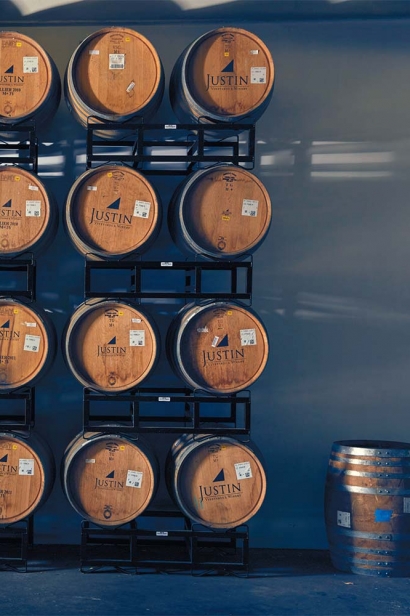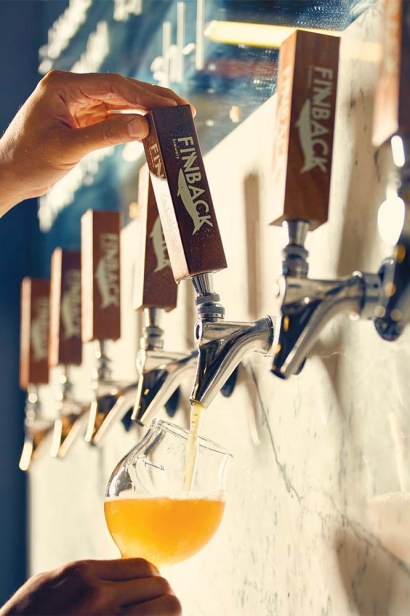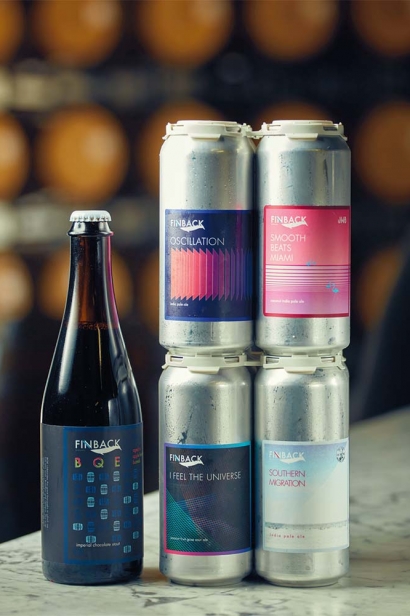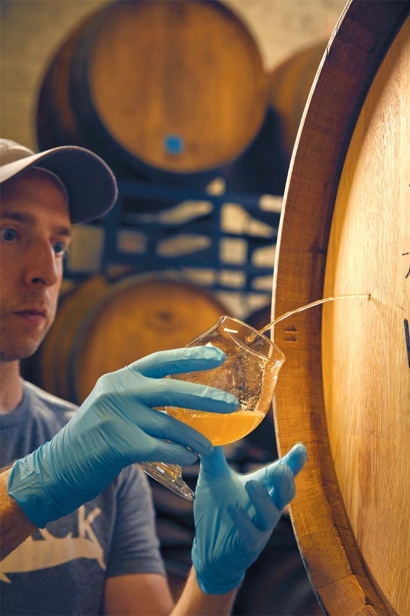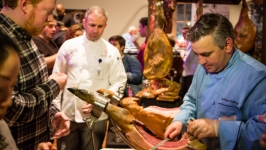New Legs for Old Kegs
Before kegs and stainless steel tanks, wooden barrels were the only vessels in which to brew, store and ship beer. The main difference? At the time, brewers strove to eliminate any flavorings that could be extracted into the liquid it held. The return to wood-barrel use—it’s important to note that lambic-beer makers never stopped since starting in the mid-1800s—welcomes this kind of external influence, however. It aligns directly with two of craft beer’s central tenets: experimentation and flavor.
On an oppressively humid afternoon this summer, Finback Brewery’s Basil Lee and Kevin Stafford gave me a tour of their company’s massive 13,000-squarefoot facility in Glendale.
Finback’s collection of wooden barrels—almost like art installations—has developed into one of New York City’s most extensive. Lee and Stafford have amassed over 200 since opening their brewery in January 2014, mostly secondhand containers made of oak that formerly held wine, whiskey or other alcoholic beverages.
Their new purpose is to store and age beer, a traditional technique revived over the last decade by adventurous craft brewers. Finback is among those producers reusing barrels, in the belief that their previous occupants—from brandy to bourbon, chardonnay to cabernet sauvignon—can enhance a beer’s flavor and aroma.
We began in the tasting room and sampled several beers—most fittingly Visible Spectrum, a delightful IPA brewed with mangoes. Its bright tropical-fruit aromas and flavors, coupled with its dry finish, provided the requisite respite from the weather. After refilling my snifter with the juicy, citrus-forward beer, the pair led me to the back of their sinuous headquarters, into a large room filled with only wooden barrels—a lot of wooden barrels, packed together tightly in stacks of two. I chatted with Lee and Stafford about their growing barrel-aging program.
Edible Queens: What inspired you to start aging your beers in barrels?
Basil Lee: We loved drinking beautiful aged sours from Belgium and from some amazing breweries making their own versions here in the States. I remember a tasting with a group of friends of the “Black Hole” series stouts from Mikkeller. There was a rum next to a wine next to a Scotch, bourbon—even a cognac. Tasting them side by side and seeing how different barrels could give such variety was exciting.
Kevin Stafford: We experimented with it as home brewers. We used oak chips soaked in bourbon and added them to an imperial stout. The base stout worked very well with the oak and bourbon characters. It was encouraging.
EQ: Do you have a favorite type of barrel to work with?
BL: I wouldn’t say bourbon barrels are our favorite, but you tend to know what you’re getting, especially with a really wet, freshly dumped one. But working with wine barrels or virgin barrels and adding bacteria and wild yeast, that’s also a lot of fun. I don’t think we have a favorite.
EQ: What's the biggest challenge in barrelaged beer?
KS: There are many considerations. It takes time, space. Even getting the barrels now, it’s a lot harder to source than when we first started. The demand is growing because everyone is barrel-aging now.
EQ: How often do you monitor a beer while it’s being aged?
KS: Honestly, we don’t bother the beer too much once it’s in barrels. Say it’s aged for a year, we might try it two or three times, and most of that is toward the end, when we’re getting ready to transfer it to bottles or a keg.
BL: You have to trust the natural process. We don’t know when a beer’s going to be ready until it is.
EQ: What’s next for your barrel-aging program?
BL: We just got two foudres straight from Italy. They took six weeks to ship.
KS: These are tall oak vats that had red wine in them previously. The smell inside right now is amazing. It’s going to be really fun to see what we add to them.
Finback currently has between 10 and 15 beers aging in barrels, all in varying stages of development. These are four expected to be released in the near future:
BQE Aged in Bourbon Barrels
Style Imperial stout
Barrel bourbon
Aged 8–10 months
There’s something special about big, full-bodied barrel-aged stouts and we knew we wanted to release one our first year. BQE was our fifth brew, about a month after we opened, and the first beer to go into barrels. It was a long journey to find a space for the brewery and we found the perfect one in Glendale. BQE was brewed as a celebration of where we lived and worked, using chocolate from Brooklyn and coffee from Queens.
We wanted to find the right touch of malt, chocolate, coffee and wood with BQE. Malt is key here, giving a touch of sweetness, as well as a foundation of toffee and roast. Cacao nibs add chocolate notes and a touch of acidity, coffee gives deep roasted character and the bourbon barrels impart vanilla and oak. Together, each component is there but no one element is dominant. It seems that we’re always aging a batch of this version, and the next should be released sometime later this year.
Unnamed
Style Gose
Barrel red wine
Aged 2–4 months
We brewed this back in early spring, and it was very much an experiment; the idea of a dark Gose was nontraditional enough, but aging it in red-wine barrels? We get excited about trying different things. A Gose is a light German-style brewed typically with wheat, coriander, salt and Lactobacillus, the same bacteria that gives yogurt its tang. We decided on a dark, barrel-aged version as an idea for a fall Gose. Midnight wheat is a dark roasted wheat which we used in a way to give color but not much of the roast flavors that comes with it. We also added lemon zest in the boil for a touch of citrus flavor. The red-wine barrels will impart a nice oak character and subtle tannins that work well with the dark base, salt and tart flavors. A final touch of lemon will add brightness and aroma at packaging, which should be later this year.
Between the Dead
Style Imperial stout
Barrel bourbon
Aged 6–8 months
Coconut is a fun ingredient to brew with. It’s familiar but also unique when it comes to beer. Last year we did a light-bodied stout called Coasted Toconut with a touch of toasted coconut, and this summer we collaborated with our friends J. Wakefield Brewing and did an IPA with coconut called Smooth Beats Miami. Coconut has a distinct flavor and the aroma feels like summer. In dark beers it can add roundness and perceived sweetness, which integrates the roasted, toasted flavors of dark malts. Coconut itself isn’t sweet but it has an aromatic sweetness. I think works well with some flavors in beer.
We’re surrounded by cemeteries here in Glendale so Between the Dead is an apt name for this Imperial stout brewed with coconut and cacao nibs. The beer is currently aging in bourbon barrels with chili and cinnamon, then we’ll transfer it back into stainless from the barrels and add a touch of coffee before packaging. Though very different in flavor, like BQE this is going to be a well-melded beer. Expect release late this year or early next.
Unnamed
Style Blonde ale
Barrel white wine
Aged 2–3 months
We brewed a beer with our friends at Other Half earlier this year at their place in Brooklyn: Lime Green Galaxies, a kölsch with kaffir lime leaves. It came out delicious and dry and perfectly hopped as Other Half beers are known to be. We invited the guys to our place in June to make something that we would release, which resulted in a blonde ale with a ton of oats that gives a silky, smooth mouthfeel and beautiful haze. It was primary fermented in white wine barrels with a yeast called Brettanomyces claussenii, giving it pineapple and fruit aromas. We wanted something bright and lively so added kumquats and dry-hopped it with Citra. It should be a perfect drink for end of summer, beginning of fall.
Finback Brewery | @finbackbrewery
Mikkeller | @mikkellerbeer
J. Wakefield Brewing | @jwakefieldbrewing
Other Half | @otherhalfnyc



